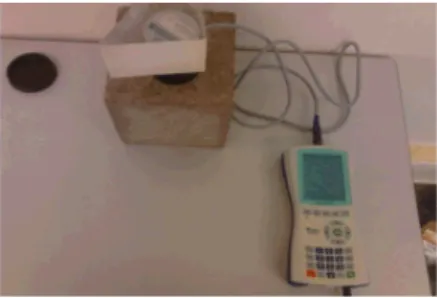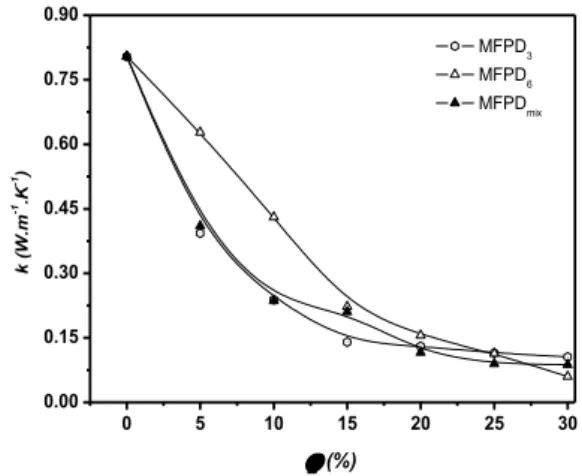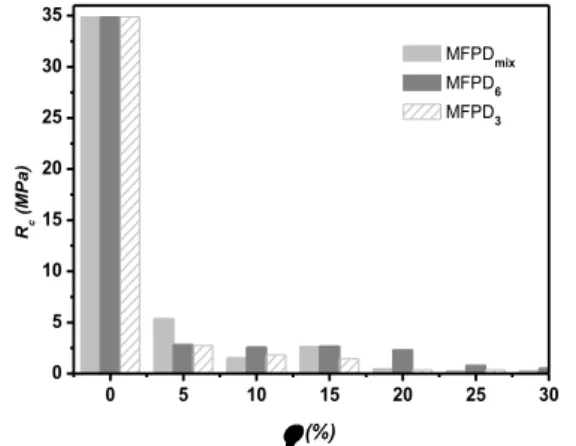EcoGRAFI
2ndInternational Conference on Bio-based Building Materials&
1st Conference on ECOlogicalvalorisation of GRAnular and FIbrous materials
June 21th - 23th 2017
Presented as poster Clermont-Ferrand, France
223
EXPERIMENTAL INVESTIGATION OF CEMENT MORTAR REINFORCED WITH
NATURAL FIBERS
A. Kareche1,2, B. Agoudjil1*, N. Channouf1,3, A. Boudenne3* 1LPEA, Université Batna 1, Algérie
2Université Batna 2, Algérie.
3Université Paris-Est Créteil Val de Marne (UPEC)/CERTES, France
*Corresponding author; e-mail: b.agoudjil@yahoo.fr and boudenne@u-pec.fr
Abstract
The big demand of energy in the building is one of several factors that have an impact on our life and environment. One of the promising alternatives to this problem is the thermal insulation of building with the use of biomaterials from vegetal and agriculture waste. These biomaterials need low energy consumption for their production, reduce CO2 emission and are renewable materials. In this work, several samples constituted with cements, sand and reinforced with a several concentration (from 5 wt. % to 30 wt. %) and size of date palm fibers (DPF) were prepared. Compressive strength and thermal conductivity measurement were conducted on these biomaterial samples. The results showed that the compressive strength and thermal conductivity decrease with the increase of DPF content. An optimal composition of this bio-concrete was find taking into account mechanical and thermal properties according RILEM classification. Finally, we have shown that our material may be great potential for use as an insulating material with favorable compression strength in the field of construction, as it can also improve the comfort level and participate to solve the problem initially noted.
Keywords: Date palm fibers, biomaterials concrete, thermal conductivity, mechanical properties
1 INTRODUCTION
At the present time, significant effort has been directed towards the use of natural fibers as well as hemp, coir, sisal, jute and date palm fibers, which are available, no health risk, a high amount in earth, as insulation in building materials with rentable and a high performance that promote sustainable development (G. Ramakrishna 2005 and Yan Li 2000). The natural fibers as date palm fibers (DPF) are a good candidate for the development of efficient insulating green materials when compared to the other materials (B. Agoudjil 2011). Inorganic or polymer matrices reinforced with date palm fibers are presently considered good thermal and mechanical properties and lightweight propriety which can be well used in building components as new composite materials for energy efficiency in the buildings (N. Benmansour 2014, M. Chikhi 2013 and M. Haddadi 2015).The worldwide production of date palm is continuously increasing which indicates the importance of the date palm wood. The utilization and industrialization of palm dates are distributed among several countries such as Egypt (1,352,950 metric tons), Saudi Arabia (1,078, 300 metric tons), Iran (1,023,130 metric tons), UAE (775,000 metric tons), and Algeria (710,000 metric tons) (M. Chandrasekaran 2013). In this work, an effort has been made to study the effect of the inclusion of
DPF on physical and mechanical proprieties of mortar cement
2 MATERIALS
The mixes used are formed with natural cement (CPJ-CEM II/A 42.5) from AinTouta-Algeria. The granulates used in this investigation are natural sand (0-5 mm) obtained from local sources of Algeria and the natural DPF are used as inclusions. This natural DPF was collected from oasis of Biskra, Algeria. It’s the petiole and the rachis dried under natural conditions. The sizes of the DPF used are fine sizes (0- 3mm), noted (DPF3), (ii) wide sizes (3- 6mm), noted (DPF6), (iii) and
mixture of those two types of fibers (50% of fine fibers +50% of wide fibers), noted (DPF mix). The various
thermophysical characteristics of DPF are already presented in the previous work (B. Agoudjil 2011).
3 PREPARATION OF COMPOSITES
The composites are obtained by mixing natural cement (CEM II 32.5), sand and water for several weight concentrations of DPF (i.e. 0, 5, 10,15 20, 25 and 30wt.%). The composites are performed by mixing the fibers, cement and sand in a mixer (40 turn/min) during 5 minutes. Dry mixing is necessary to homogenize the mixture, so water is then added gradually.
ICBBM & ECOGRAFI 2017
224 The rate of mixing water (W/C) is varied according to the weight concentrations of DPF and then the mix was placed in molds (Fig.1) to prepare two kinds of
samples namely cubical (150mm×150mm×150mm)
and prismatic (40mm×40mm×160mm). Drying of the samples was performed in the open air for 48 hours in the molds and 28 days after demolding at room temperature and an oven curing at 65 ±2 °C, until constant weight. The proportions of the materials used in mixtures are provided in Table 1.
Table 1: proportions of the materials used in mixtures
Cement(%) Sand(%) DPF(%) W/C 72.52 27.48 0 0.35 69 26 5 0.42 66 24 10 0.54 62 23 15 0.68 58 22 20 0.80 55 20 25 0.90 51 19 30 1
Fig.1: The molds and composites.
Three types of composites were obtained: MDP3: Sand+cement+DPF3
MDP6: Sand+cement+ DPF6
MDPmix: Sand+cement+DPFmix
4 MEASUREMENTS METHODS
4.1 Total water absorption test
This test consists of drying the samples in an oven for 24 hours at a temperature of 70± 2 °C to ensure total moisture loss and then immediately weighed to the nearest 1mg (this weight was designated Wd) by a
Sartorius balance (model PT150). Thereafter, the specimens were immerged in water at room temperature for different time periods from 5 min after which they were removed and droplets of water on their surfaces were mopped with dry cloth, immediately weighed (this weight was designated Wt) and then
returned to the water until saturation. The percentage of water absorption in the samples was calculated by weight difference between the samples immersed in water and the dry samples using the following equation:
A(%) = (Wt− Wd)×100 Wd (1)
Where A (%) is the percent water absorption, Wd is
weight of the samples dried and Wt is the weight of the
samples after every time of immersion in the water.
4.2 Thermal conductivity measurement
Thermal conductivity measurement was performed using the device ISOMET (Fig. 2). The measurement is based on the analysis of temperature response of the analyzed material to heat flow impulses. Heat flux is excited by electrical heating of resistor heater inserted into the probe which is in direct heat contact with the tested sample. Evaluation of thermal
conductivity and volume heat capacity is based on periodically sampled temperature records as function of time. The surfaces of all samples were polished to achieve smooth surfaces in order to insure a good thermal contact between the sensor surface and the specimen.
Fig.2: The device ISOMET.
4.3 Mechanical testing
Compressive and flexural strength tests (Fig.2) were carried out according to NF EN196-1 and EN196 respectivly. For each test and type of composite, three specimens were tested and the average values are reported. The compressive strength are determined by an apparatus, type Controlab, precision of 0.001 MPa, loading speed of 0.5 MPa/s, at 28 °C. The compressive strength is tested on cubic specimens (150 mm × 150 mm × 150 mm). The flexural strength by an apparatus, type Toni Technik, the precision of 0.001kN, loading speed of 0.05 kN/s, at 28 °C
Fig.2: Compressive strength test (Left), flexural strength (Right).
5 RESULTS AND DISCUSSION
5.1 Total water absorption
Fig.3 shows the evolution of the water absorption of the date palm fibers (DPF), pure cement mortar (MR) and bio-composite reinforced with 5,10 and 15% DPF(MDPF5, MDPF10 and MDPF15 respectively) as function of immersing time. We estimate the water absorption is important after 35 min for the DPF, its average of 184 %, and the water absorbed in the same time of the MR, MDPF5, MDPF10 and MDPF15 are 13, 21, 28 and 33% respectively. On the other side, the evolution of the water absorption in the MR, MDPF5, MDPF10 and MDPF15 composites from 5 min to 10 min is less significant, with slight increases of 3, 1, 1.3 and 2 % respectively. In same time interval the DPF has absorbed about 65% of the water. It is also shown from Fig.3 that the DPF has more absorbed water (until saturation) in a short time. As underlined in the thesis (N. Benmansour 2014). It is against in comparison with the MR or the bio-composite, that research behavior agrees with the results found by (A.
ICBBM & ECOGRAFI 2017
225 Le Duigou 2014 ).They studied the saturation of the flax fibers and polymer and bio-composite, found in this case, the saturation of the flax fibers is clearly higher than the bio-composite or matrix values. Understanding of the rate of the total water absorption (TWA) of a bio-composite is essential because it can be used for estimate of the voids content of a bio-composite and then according to amount of the DPF its existence which also recorded increase in water absorption of cement mortar with increase in date palm fibers content. The increase may be attributed to the amount of water absorbed by the cellulose of the fibers, which is due to the void volume and the amount of cellulose material present in cement mortar (A.R. Jeefferie 2011).
The results illustrated in Fig.3 shows that there is an increase in the TWA for about three days on the MDPF5, MDPF10 and MDPF15 with increase in the DPF content on comparison with pure cement mortar (MR). The increase is 7% between variations in DPF content from 5% to 15%. It was found that the TWA of bio-composite ranged between 25.31% and 36 %. The values obtained of saturation water absorption were good when compared with those of such as materials (20% flax/PLA; 12%) b (A. Le Duigou 2014)
Fig.3. Water absorption of pure cement mortar, DPF and DPF coupled with mortar.
5.2 Thermal conductivity
Fig. 4 illustrates the evolution of the thermal conductivity as a function of the DPF content. It can be noticed that the addition of DPF into the mortar matrix reduces the thermal conductivity of the composite. This reduction is expected because the date palm fibers have a lower thermal conductivity (B. Agoudjil 2011) compared to that of mortar matrix. Besides, the fact that the fibers are embedded in composite tends to generate porosity and air in the matrix and reduced the density. So, the first advantage of the use of natural fibers is the lightening of the composite. For concentrations 5, 10 and 15% of DPF, the thermal conductivity of the composite reinforced with wide fibers (MDP6) higher compared to the composites
reinforced with fine fibers (MDP3) and mix fibers
(MDPmix). The thermal conductivity of porous materials
is governed by the voids in the sample. These voids are occurring from packing of fibers. In general, short fibers are more difficult to align and pack densely than the larger one (J. Khedari 2001). Thus, for a given fibers content, mortar filled with short fibers result in an increase of the number of voids, this generates lower density and low thermal conductivity of composites. For concentrations 20, 25 and 30% of DPF, it turns out in our case that the influence of the size of the fibers
on the thermal conductivity of the composite is negligible. Thereby, according to the Fig. 4, the
decrease of thermal conductivity is about 92.5% for the samples MDP6, 87% for the samples MDP3 and MDP mix, for the fibers content of 30%.This diminution is
related to the important difference between the thermal conductivities of the materials used (fibers and matrix) and to the insulating character of the fibers of DPF, which have a thermal conductivity of 0.083 W.m-1.K -1(B. Agoudjil 2011). Similar behavior was reported by
(A. Ledhem 2000), they studied the effect of components (such as clay, schistous fines, cement and wood shavings) on the performances of hardened composites. From their results, the thermal conductivity decreases with increasing of wood shaving content and the reduction of thermal conductivity is about 85 % for the weight fraction of wood shaving of about 30%.
Fig.4.Thermal conductivity of composite as function of DPF content
5.3 Compressive strength
Fig.5 shows the variation of the compressive strength of the composites as a function of the fibers content. It is noticed from the Fig.8 that the compressive strength decreases with the increasing of date palm fibers content. For 5% DPF, the compressive strength of composites decreases of about 92% for MDP3, 91.90%
for MDP6 and 85% for MDP mix.This behavior is due to
the increase of fibers content that leads to a low density of samples. In fact, at high content, if the fiber is stiff, the packing of the fiber becomes difficult and voids are introduced into the composite (J. Khedari 2000).Thus, the decrease in compressive strength is related to (i) the low mechanical strength of the inclusions and, (ii) the increase of the porosity in the matrix due to air entrainment, (iii) the poorer fibers/matrix adhesion (D. Taoukil2012). The maximum compressive strength was obtained for MDPmix for
percentage of fibers of 5%, which remained very lower than that of the mortar without fibers. These results are in agreement with other works (A. Kriker2005) theoretically, the addition of date palm fibers into a cementitious matrix would reduce the compressive strength of the composite. The increased porosity of the composite material as a result of fibers addition is the major factor responsible for the reduction in compressive strength, which is in agreement with literature results (R. MacVicara 1999).
It should be kept in mind that the mix of fibers reinforced mortar was made with more water than the mix without fibers. Thus, the hardened fibers-reinforced mortars were more porous and hence less resistant then that of the mortar without fibers.
0 5 10 15 20 25 30 0.00 0.15 0.30 0.45 0.60 0.75 0.90 k (W .m -1.K -1) (%) MFPD3 MFPD6 MFPDmix
ICBBM & ECOGRAFI 2017
226 The composite containing 5, 10 and 15% DPF of the instance satisfies the thermal and the mechanical requirements of construction materials as structural and insulating concretes, according to the functional classification of RILEM (RILEM 1978).
Fig.5. Strength compressive of composites as function of concentration of DPF
5.4 Flexural strength
The flexural strength of composites containing 0, 5, 10 and 15% DPF at days 28 is shown in Table 2. We notice see that the flexural strength of these composite have same behavior of compressive strength. That the flexural strength decreases with the increasing of date palm fibers content. This result is in agreement with the work of (M. Chikhi 2013) relating to the study of the mechanical properties of date palm fibers filled gypsum material
Table 2: Flexural strength of composite.
Composites Flexural strength (MPa) MR MDPF5 MDPF10 MDPF15 4.4 2.15 0.7 0.45 6 CONCLUSION
This experimental study analyzes the use of DPF as reinforcement in cement mortar matrix. The goal is to evaluate the possibility of using this composite mortar/DPF as insulating material to reduce the heat loss in buildings.
The experimental investigations indicated that the increase of DPF content allows increasing the water absorption of mortar matrix and increases insulating capacity of mortar by decreasing its thermal conductivity. On the other hand, the compressive strength values were obtained at low concentration DPF (5%, 10%, and 15 %) and the flexural strength is decreased with increasing the DPF content. Consequently, it can be concluded that using 5%, 10%, and 15% of DPF loading in the mortar matrix, allows obtaining a composite with good thermal and mechanical properties which can be well used in building components as a new biocomposite materials for energy efficiency in the buildings
7 REFERENCES
B. Agoudjil, A. Benchabane, A. Boudenne, L. Ibos, and M. Fois, "Renewable materials to reduce buildings heat loss: characterization of date palm wood," Energy
and Buildings, vol. 43, pp. 491-497, 2011.
N. Benmansour, Développement et caractérisation de composites naturels locaux adaptes a l’isolation thermique dans l’habitat," thèses, Laboratoire de Physique Energétique Appliquée (LPEA), l’Université Hadj Lakhdar de Batna, Algerie, 2014
M. Chandrasekaran, and A. H. Bahkali, " a review on valorization of date palm (Phoenix dactylifera) processing by-products and wastes using bioprocess technology," Saudi Journal of Biological Sciences, pp. 105-120, 2013.
M. Chikhi, B. Agoudjil, A. Boudenne, and A. Gherabli, "Experimental investigation of new Bio-composite with low cost for thermal insulation," Energy and Buildings, vol. 66, pp. 267-273, 2013.
M. Haddadi; Propriétés de transport des matériaux hétérogènes a renfort naturel: approche expérimental et modélisation numérique, doctorat thesis, Laboratoire de Physique Energétique Appliquée (LPEA), Université Hadj Lakhdar de Batna, algerie ,2015
Jeefferie AR, Nurul-Fariha O, Mohd-Warikh AR, Yuhazri MY, Sihombing, Ramli HJ, Preliminary study on the physical and mechanical properties of tapioca starch/sugarcane fiber cellulose composite, engineering applied science 6 (2011) 1819–1828 J. Khedari, B. Suttisonk, N. Pratinthong, J. Hirunlabh, New lightweight composite construction materials with low thermal conductivity,Cement & Concrete Composites23(2001) 65-70.
A. Kriker, G. Debicki, A. Bali, M. M. Khenfer, and M. Chabannet, Mechanical properties of date palm fibres and concrete reinforced with date palm fibres in hot-dry climate, Cement and Concrete Composites 27(2005) 554-564.
A. Ledhem, R.M. Dheilly, M.L Benmalek, and M. Quéneudec,Properties of wood-based composites formulated with aggregate industry waste, Construction and Building Materials14(2000) 341-350.
A. Le Duigou, A. Bourmaud, P.Davies, and C. Baley, " Long term immersion in natural seawater of Flax/PLA bio-composite," Ocean Engineering, vol. 90, pp. 140-148, 2014.
Y. Li, Y. W. Mai, and L. Ye, "Sisal fiber and its composites: a review of recent developments,"
Composites Science and Technology, vol. 60, pp.
2037-2055, 2000.
R. MacVicara, LM. Matuanab, and JJ. Balatinecza, Aging mechanisms in cellulose fiber reinforced cement composites, Cement Concrete Composite21(1999) 189–196.
G. Ramakrishna and T. Sundararajan, "studies on the durability of natural fibers and the effect of corroded fibers on the strength of mortar," Cement & Concrete
Composites, vol. 27, pp. 575-582, 2005.
RILEM, Functional classification of lightweight concrete, Recommendation of RILEM LC 2(1978) 281-283. D. Taoukil, A. Albouardi, T.Ajzoul, and A. H. Ezbakhe, Effect of the incorporation of wood wool on thermophysical properties of sand mortars, KSCE, Journal of Civil Engineering 16(2012) 1003-2010.
0 5 10 15 20 25 30 0 5 10 15 20 25 30 35 Rc (MPa ) (%) MFPD mix MFPD6 MFPD3


